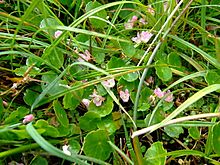Brassey SSSI facts for kids
| Site of Special Scientific Interest | |

Example - Bog pimpernel
|
|
| Area of Search | Gloucestershire |
|---|---|
| Coordinates | 51°53′58″N 1°47′55″W / 51.89952°N 1.79866°W |
| Interest | Biological |
| Area | 2.1 ha (5.2 acres) |
| Notification | 1954 |
Brassey is a special natural area in Gloucestershire, England. It covers about 2.1 hectares (around 5 acres). This site is officially known as a Site of Special Scientific Interest (SSSI). This means it's a protected area because of its unique plants, animals, or geology. Brassey was first recognized as an SSSI in 1954.
You can find Brassey on the north side of the River Windrush valley. It's located between the villages of Naunton and Upper Slaughter. The area has sloped grasslands made of limestone. These grasslands haven't been changed by farming. There's also a fast-flowing stream here. This stream eventually joins the River Windrush. Brassey is one of the few freshwater marshes in all of Gloucestershire.
This special place is part of the Cotswolds Area of Outstanding Natural Beauty. This is a large area recognized for its beautiful landscapes. Brassey is also listed as a Key Wildlife Site (KWS) in the local plans for the Cotswold District.
The site is named after a person who used to own the land. It was once used for farming and growing watercress. There was even a waterwheel and a small building that pumped water up to a reservoir on the hill.
Since 1964, the Gloucestershire Wildlife Trust has helped manage Brassey. It's actually part of a bigger SSSI called Brassey Reserve and the Windrush Valley. This larger protected area covers about 14.48 hectares (around 35 acres).
Contents
Amazing Plants of Brassey
Brassey is home to many different kinds of plants. You can find out more about them in special handbooks from the Gloucestershire Wildlife Trust.
The Marsh: A Wetland Wonderland
The marshy areas at Brassey are full of interesting wetland plants. Some plants found here are quite rare in Gloucestershire. These include the beautiful bog pimpernel and the marsh lousewort. You can also spot common cotton-grass, skull-cap, ragged-robin, and the southern marsh-orchid.
Many types of sedges (grass-like plants) grow here too. One very special sedge is the dioecious sedge. This is the only place in Gloucestershire where it has been recorded! A unique plant in the marsh is the tussock-sedge. It forms tall clumps, about 2 to 3 feet high. About forty different flowering plants grow on these tussocks. These plants are called epiphytes, which means they grow on other plants but don't harm them.
Around the edges of the marsh, you'll find different trees. These include ash trees, buckthorn, and various kinds of willows.
Grasslands and Wildflowers
The sloping grasslands at Brassey are a great example of "oolitic limestone grassland." This means the soil is rich in a special type of limestone rock. In spring and summer, these grasslands burst with color. You can see hairy violet, cowslip, kidney vetch, common rock-rose, and autumn gentian.
Some less common plants also grow here. These include the chalk milkwort and the purple milk-vetch. One of the rarest plants at Brassey is the bastard toadflax. This plant is semi-parasitic, meaning it gets some of its food from other plants. You can usually see it in July.
Cool Creatures of Brassey
Besides plants, Brassey is home to many interesting animals.
The yellow meadow ant builds many anthills here. These anthills show that the grassland has been undisturbed for a very long time. You might also spot glow-worms at night. These are actually beetles that glow! The area has many different insects and other small creatures. This includes the purse-web spider. On hot days, you might even see Lizards basking in the sun.
Many types of butterflies flutter around Brassey. Look for the Duke of Burgundy and the small blue. Birds that live in the grasslands and wetlands include the dipper, kingfisher, yellowhammer, and tree pipit. Reed buntings also build their nests in the marshy areas.
Protecting Brassey
To keep Brassey healthy, people work to protect it. Sheep sometimes graze on the grasslands. This helps keep the grass short and open. They also remove unwanted plants from the wetland areas. These invasive plants include monkey-flower, purple moor-grass, and blunt-flowered rush. This careful management helps the special plants and animals of Brassey thrive.

